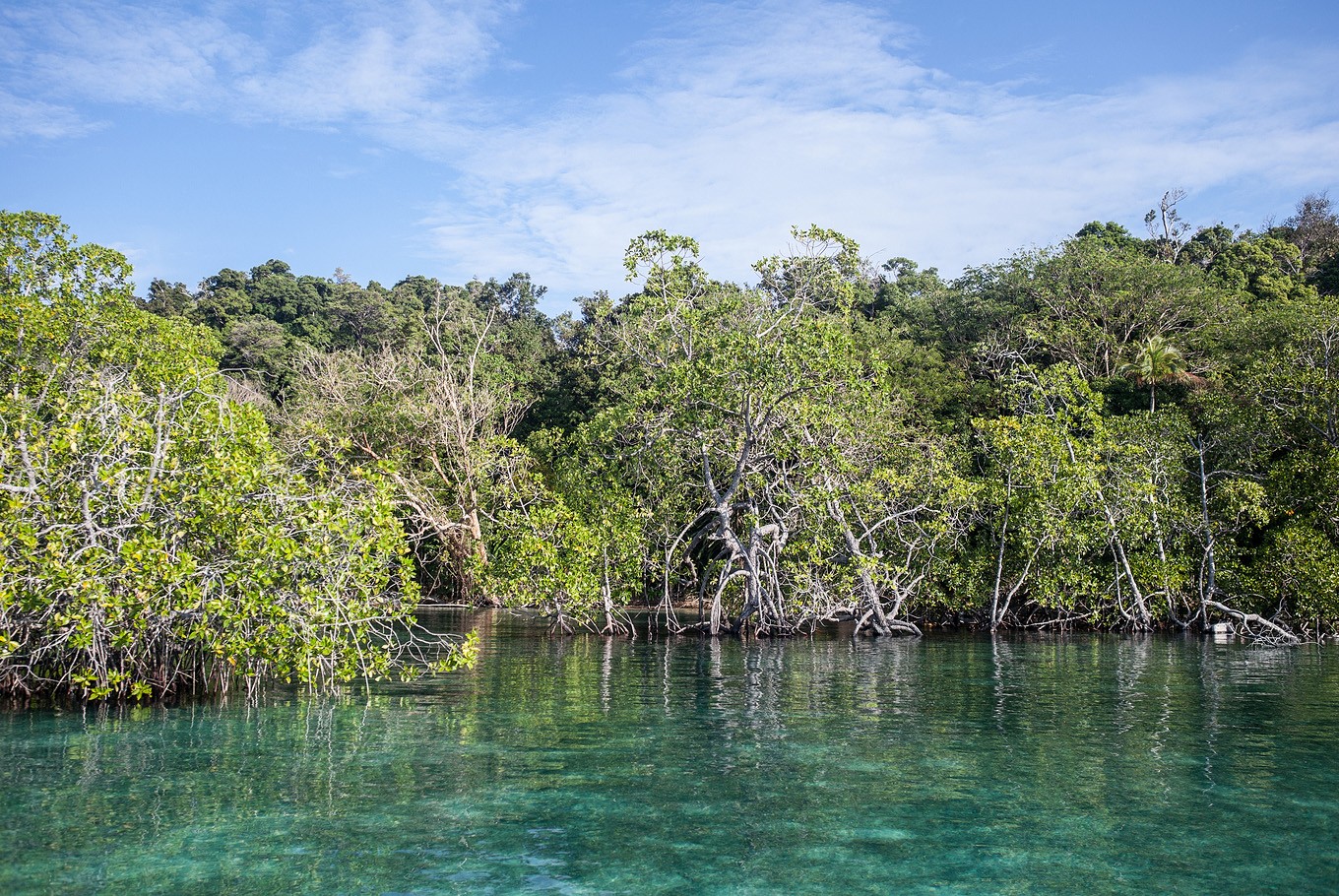FEATURE STORY World mourns the loss of beloved King

THAILAND – The name Bhumibol means "Strength of the Land," and the bounty of Thailand's soil and waters was the king's passion. In 1952 he set out to breed a better freshwater fish, a staple of the Thai peasantry, in the ponds of his Chitralada Palace in Bangkok. It was the first of more than 4,300 palace-sponsored development projects now blanketing the country. King Bhumibol has been praised for lifelong support of village development. He has personally launched more than 4,000 development and social welfare projects, according to a tally from the Thai government, in areas such as irrigation, agronomy, forestry, fishing and health. He introduced improved strains of rice, stocked streams with fish, established irrigation projects. He used to frequently helicopters around the country doing things like promoting dam and irrigation projects and encouraging Golden Triangle farmers to switch from opium to kidney beans. His rural development projects are credited with weaning highland off opium amd helping to stop the expansion of the Communist movement in Thailand. To clean up the highly polluted Makasan swamp, the King developed an inexpensive natural filter relying on water hyacinths, which have a great capacity to absorb wastes. After absorbing pollutants the saturated plants are detoxified and used as fuel, compost and material for making baskets and place mats for poor people who live around the swamp. He also introduced paddle-wheel-like devices that aerate the water in the stagnant pools of Bangkok's Bavornnives Temple. Fish have returned to Makasan swamp and turtles once again occupy the pools of Bavornnives Temple. READ MORE AFRICA A Burning Problem For Mangroves

MADAGASCAR – Beyond Antananarivo—Madagascar’s capital city—signs of urbanization give way to sprawling farms and sweeping grasslands. At the coastal city of Toliara to the south, after a full day’s journey, the road turns into tire-sucking sandy track that mainly serves cattle-drawn wooden carts. For seven more hours, travelers cross a desert marked with spiny trees, where the sun bakes everything to a dusty crisp. Finally, the Bay of Assassins appears, an oasis thrumming with life, fringed with lush evergreen mangroves. A mangrove forest is unlike any other. At low tide, the trees loom from exposed mud, balancing on woody, tangled roots like ballerinas en pointe; at high tide, cool seawater erases the dry world, transforming the scene into an underwater spectacle. Glassy shrimp hover, their legs flickering with movement. Tiny metallic fry shimmer past, while adults lurk in the shadows. Slim tree roots stick up like pencils poked into the forest floor. Hermit crabs shuffle along thicker, oyster-encrusted roots that loop down through the water. Scattered around the bay’s 40-kilometer shoreline, 10 subsistence communities also rely on the mangroves’ offerings: from food, fuel, and building materials to erosion control and shelter for the young fish that will grow up to stock fisheries. READ MORE ASIA Ditch Coal — Save the Last Tigers!

BANGLADESH – Banks are dishing out millions to build a planet-frying coal plant, right next door to the mega forest that’s home to some of the last Bengal Tigers. It’s the worst example of our disconnection from nature but we can stop it. After a leaked UN report slammed the project in Bangladesh, we went straight to the international banks. Now they’re scrambling to figure out what to. If we turn up the pressure on JPMorgan, Crédit Agricole and others, we can make this so toxic that they’ll quit the project for good. Both JPMorgan and Crédit Agricole have ditched similar projects in the past. Let’s build a million-strong cry to save the tigers and convince their CEOs to pull out. Sign now to save the last tigers. READ MORE Kids Mangrove Action Day activities at Ban Ta Sanook in Phang Nga
THAILAND – Students in Ban Ta Sonook Thailand share their short 3min 30sec video of MAP's Mangrove Action Day activities at Ban Ta Sanook in Phang Nga, Thailand The school children experienced the new mangrove nature trail which was constructed under Daimler AG supported project. A resource person from the Department of Marine and Coastal Resources (DMCR) provided information on the flora & fauna found along the trail. The video was produced by Khun Donnapat of Raks Thai Foundation, one of MAP's partners. Although it's in Thai you can get an idea of what went on. VIEW VIDEO Exec. Director’s Note: While this article below recommends that NGO activists opposing the shrimp industry in Indonesia should try to instead partner with industry to ensure much fewer mangroves are lost in the future. My question is simply what this author sees NGOs actually doing within such a partnership?
Fate of Indonesia's mangroves lies in shrimp aquaculture

INDONESIA – Mangroves are extremely important for mitigating global climate change and protecting communities from storm surges, coastal erosion and tsunami. They also provide food, building materials and medicine. Indonesia has the largest areas of mangroves in the world. Unfortunately, the country’s shrimp industry is causing massive mangrove deforestation. In a study for which I am one of the researchers, we contend that mangrove conservationists in Indonesia should work together with shrimp producers to save mangroves. Here is why. For Indonesian, mangroves are crucial for the local economy. They directly support shrimp industries that earn about US$1.5 billion annually from exports alone, supporting the livelihoods of more than 1 million Indonesian people. The facts showed that shrimp is the most important species in the country’s fishery sector. Unfortunately, the benefits of shrimp come with costs, particularly to the mangrove ecosystem. By helping them put the current shrimp production system back on track, shrimp producers would not only satisfy demand but also restore vast abandoned farms back into being mangroves. READ MORE Rates and drivers of mangrove deforestation in Southeast Asia, 2000–2012
INDONESIA- This study quantifies the proximate drivers (i.e., replacement land uses) of mangrove deforestation across Southeast Asia between 2000 and 2012. Mangrove forests in the region were lost at an average rate of 0.18% per year. Aquaculture was a major pressure on mangrove systems during this period, but its dominance was lower than expected, contrary to popular development narratives. Rice agriculture has been a major driver of mangrove loss in Myanmar, and oil palm expansion is a key but under-recognized threat in Malaysia and Indonesia. The threat of oil palm to mangroves is likely to increase in the future as new frontiers open up in Papua, Indonesia. Future research and policy responses must consider the diversity of drivers of mangrove deforestation. READ MORE AMERICA Myths & Legends Book Brings Alive Mangrove Stories from ‘Round the World
 CAYMAN ISLANDS – The stories which surround the world’s mangrove forests come alive in the new book from Brac author Martin Keeley, Marvellous Mangroves Myths & Legends. Beautifully illustrated by Brac artist Daniella Christian the book features enchanting stories from around the world of mangroves – including Cayman – that bring to the reader the magic of goddesses, guardians, lost boys and ghosts. Mr. Keeley explains that during his travels to the countries which host the world’s mangrove wetlands he discovered that the mangroves are intimately associated with popular culture. Take a country like Brazil, for example, which has one of the longest mangrove-covered coastlines of all the nations of the world. “In the northern state of Pará it is believed that mangroves and salt flats are home to entities such as the Matinta-Pereira, the Boiúna, and the Mãe-do-caranguejo (the latter is compared to another entity, the Curupira),” he says. “These creatures are supposed to induce a feeling of agony to those who interfere in the environment. The unfortunate soul will then lose its way back home. READ MORE Marvellous Mangroves Curriculum Continues to Grow Worldwide

CAYMEN ISLANDS – A busy year so far has seen MAP’s Marvellous Mangroves (MM) curriculum making the big time in Asia, South America and the Caribbean with preparation for at least two more countries in the coming year. The year began with a visit to Shenzhen in mainland China. Working in conjunction with the Chinese Mangrove Conservation Network (CMCN) The Youyun Ecological Education Studio and the Yantian Foreign Languages School’s Ecological Education Centre, MAP’s education director, Martin Keeley, together with veteran environmental education teachers Steven Chen and Ms. Mabel Yo, ran several workshops and activities for teachers and students alike. Highlight of the trip was a special event in Shenzhen’s Sunset Park celebrating the life of threatened Blackfaced Spoonbill which is being adopted at Shenzhen’s “official”bird. Following the Chinese training programs, Mr. Keeley‘s text workshop –one that has become an annual event was held in Freeport, theBahamas, in conjunction with EARTHCARE led by Gail Woon, where students from the Ecokids group, togethe with adults took part in a series of activities. Several schools also participate in exploratory workshops followed by fieldtrip to Lucayan National Park. Many programs were also conducted in the “home” of Marvellous Mangroves – the Cayman Islands. READ MORE The Importance of Mangroves … for Social and Environmental Preservation
MEXICO – This past month, September 2016, we, the planet, have officially passed the threshold (400 ppm) of carbon in our atmosphere. If we, in spite of everything are lucky enough to finish out our lives with enough clean air to breathe, history books will look back on this moment in time as the major event marking the world’s deteriorating environment; to be specific, AIR…number one importance to the existence of life. Remember, without oxygen for us to breath, we have approximately 7 minutes before our hearts fail to pump and we die…7 minutes at its maximum. Latest news from meteorologist researching the atmosphere, explain that Arctic stored methane is being released now from under the ice caps, from the bottom of the seas, unnoticed to the eye. This phenomenon is called deglaciation. It is intensified by global warming. This results in the ‘methane release effect’. Methane is itself a most powerful greenhouse gas, and these gases trap heat in our atmosphere, with a snowball effect…a process that started gaining momentum a few decades ago. While methane doesn’t linger as long as carbon dioxide, it is initially far more devastating to the climate because of how effectively it absorbs heat. In the first two decades after its release, methane is 84 times more potent than carbon dioxide. Both types of emissions must be addressed if we want to effectively reduce the impact of climate change. This methane and carbon is not just limited to the arctic seas, but also is stored in Mexico’s coastal mangroves… in the leaves, the stems, the trunk, the roots and the mud. Mangroves are natural carbon-scrubbers, taking carbon out of the atmosphere and storing it away. These mangrove forests then return to us this precious and most important to our lives, clean perfect oxygen, sequestering carbon for millennia in their rich soils. We must give thanks to that word “sequestered”. READ MORE OCEANA Dugong deaths along Queensland coast spark calls for testing to prevent further losses

AUSTRALIA – Four dugongs have been found dead along the Queensland coast in the past week, sparking calls for testing to prevent further losses. Recently, carcasses have been found south of Mackay, at Hervey Bay and north and south of Townsville. One drowned in a commercial fishing net. Jim Higgs from the World Wildlife Fund said Queensland's environment department had not done testing to find out how the animals died. "Most of the animals we've seen over the last week have been in a situation where an internal investigation would have been possible to see if the animal had ingested something that had caused a blockage or if it had drowned," he said. READ MORE LAST WORD What? No Last Word? Send your letters and comments BACK TO TOP
Not yet a subscriber? Click here to subscribe. Please cut and paste these news alerts/ action alerts on to your own lists and contacts. Help us spread the word and further generate letters of concern, as this can make a big difference in helping to halt a wrongdoing or encourage correct action. ACTION ALERTS WANTED: MAP News is looking for links to calls to actions/petitions and letter writing campaigns on mangrove issues, tropical coastal communities and other related topics. Not all submissions can be selected, but we look forward to hearing about your work and want to let our readers' voice be heard!
Email submissions to news@mangroveactionproject.org | Action Alerts:VOTE The Nagenahiru Project on Solar Power for Night Fishing in Sri Lanka is selected as a finalist by the Water, Air and Food Foundation in Denmak. VOTE HERE 
MAP is happy to announce that we are now accepting orders for our 2017 Children's Mangrove Art Calendar . This is our 16th annual edition of Children's Mangrove Art, and this Calendar is celebrating MAP's 25th Anniversary! Please order your calendars now, and help us celebrate a quarter century of MAP's work to Save the Mangroves!" The world's largest mangrove forest is in danger from a massive coal plant.
UNESCO can put pressure on India and Bangladesh to protect the forest, but they need to see that people around the world are speaking out. Click here to add your voice. Our new short documentary, Reducing the Risk of Disaster through Nature-Based Solutions : Mangroves 
Tell Red Lobster its "Endless shrimp" deal is damaging and unfair to the workers SIGN THE PETITION
Mangroves: Guidebook to Malaysia – available for download here
Mangrove rehabilitation in Asia – Local Action and cross-border Transfer of Knowledge for the Conservation of Climate, Forests and Biodiversity VIEW VIDEOS HERE Volunteer Opportunities with Mangrove Action Project CLICK HERE
STOP PLANTING MANGROVES ON SEAGRASS BEDS _ A CALL TO ACTION What is CBEMR? Easy to follow fact sheet – CLICK HERE SHARE MAP'S VISION
CLICK HERE to watch short introductory video. Together we can work "at the roots of the sea". Join us in saving our beautiful country!
We hope you have been following the ongoing battle in Bimini, Bahamas.
We are in need of your help more than ever Click here
Exclusive Interview with Alfredo Quarto, Co-Founder and Executive Director of Mangrove Action Project – See more
Marvellous Mangroves Curriculum Marvellous Mangroves Curriculum in Bangladesh – WATCH VIDEO MARVELLOUS MANGROVES IN BRAZIL
En Portuges Check out our presentation for more details on Marvellous Mangroves “Education In The Mangroves" can now be seen on the PhotoPhilanthropy website here! Read this 10 page history of the development of MAP’s educational curriculum VIEW DOCUMENT
Article in Canada's Green Teacher Magazine – Read More
FREE MAP Mangrove e-cards CLICK HERE
 MAP’s e-Cards offer you a unique way to spread the word about MAP’s good works, while sharing beautiful photographs of the mangroves
Donate to MAP via Paypal
Giving could never be easier
It’s the action, not the fruit of the action, that's important. You have to do the right thing. It may not be in your power, may not be in your time, that there'll be any fruit. But that doesn't mean you stop doing the right thing. You may never know what results come from your action. But if you do nothing, there will be no result. —Mahatma Gandhi
Green Planet Fundraising Assists MAP – LEARN MORE
MANGROVE ISSUES The importance of restoring mangroves in an effective, long-term manner. Mangrove CBEMR video – VIEW Question Your Shrimp Consumer/Markets Campaign! WATCH VIDEO Mangrove Restoration in Asia – Watch Short Video 
READ A MOSAIC OF LIFE Peek into the underwater world of mangroves, "womb of the sea." By Liz Cunningham Photos By Wes Matweyew and Liz Cunningham
"Question Your Shrimp" Campaign Learn more about the affects of the shrimp industry on mangroves by visiting our blog Editor’s Note: Mangrove Action Project’s Executive Director, Alfredo Quarto was interviewed about shrimp by Green Acre Radio’s Martha Baskin Information sheds clear light on shrimp-mangrove connection

Not yet a MAP News subscriber?
Click here to subscribe.
Note to Our Readers:
We strive to keep active links in our newsletter. However, due to circumstances beyond our control, occasionally links to stories may become broken. If you find a link to a story is not functioning, please cut and paste the headline into your browser search bar. In most cases you should be able to locate the original story.
Help Mangrove Action Project through your recycled E-Waste. List of Accepted E-waste Items:Injet Cartidges, Cell Phones, Pagers, GPS, Radar Detectors, Mobile Hot Spots, Calculators, eBook Readers, iPods/MP3 players, Digital/Video Cameras/Camcorders, PDAs, iPads/Tablets/Laptops, Video Game Consoles, Handheld Video GamesVisit the Mangrove Action Project recycle website Click on the recycle button then click on the Download Shipping Label, and follow the instructions. 
|
















